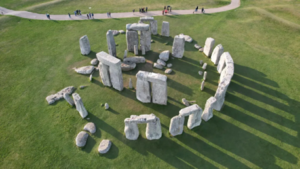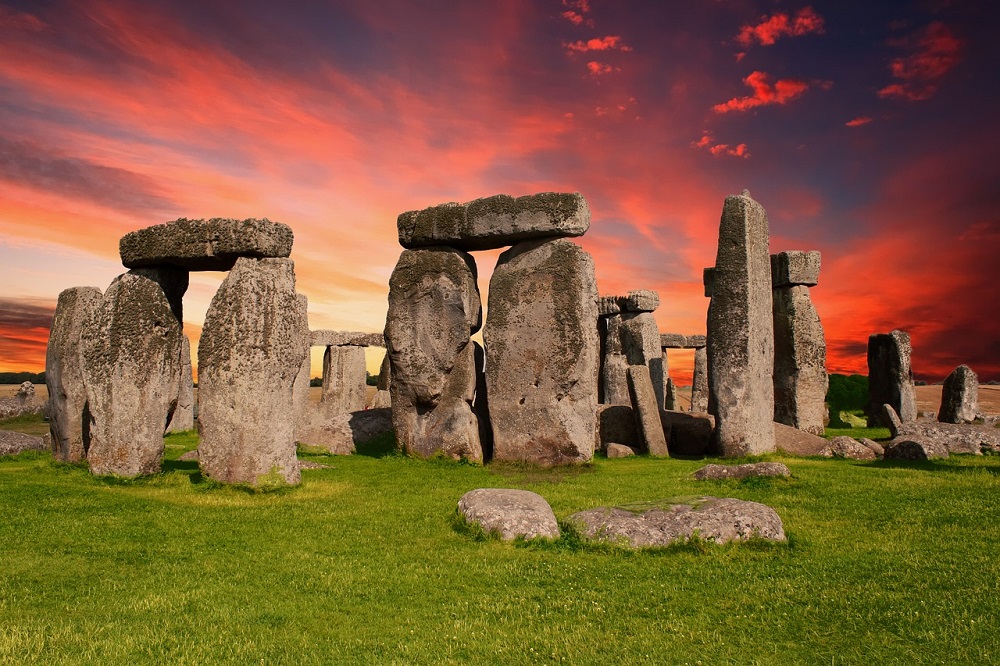Stonehenge, situado na planície de Salisbury, no sul da Inglaterra, é um dos monumentos mais emblemáticos e misteriosos do mundo. Composto por um círculo de pedras gigantes erguido há cerca de 5000 anos, Stonehenge continua a fascinar e intrigar estudiosos, arqueólogos e turistas. Este lugar místico é cercado por uma aura de mistério, teorias sobre sua origem, e histórias de poderes sobrenaturais, tornando-se um destino imperdível para aqueles que buscam entender os enigmas da história e os mistérios do universo.
ÍNDICE
- A Origem de Stonehenge: Um Passado Envolto em Mistério
- O Propósito de Stonehenge: Teorias e Especulações
- Pesquisas Realizadas: O Que a Ciência Revela Sobre Stonehenge?
- O Misticismo de Stonehenge: Lendas e Superstições
- Por Que Visitar Stonehenge?
- Considerações Finais: O Legado Eterno de Stonehenge
1. A Origem de Stonehenge: Um Passado Envolto em Mistério
A origem de Stonehenge está repleta de incertezas. Este monumento pré-histórico começou a ser construído durante o período Neolítico, por volta de 3000 a.C., e continuou a ser modificado ao longo de vários séculos. A primeira fase de construção consistiu em um anel de fossos, conhecido como “henge”, dentro do qual foram erigidos os primeiros pilares de pedra. O local foi gradualmente ampliado, com a adição das imponentes pedras sarsen e das enigmáticas pedras azuis, que foram transportadas de distâncias surpreendentemente longas.
2. O Propósito de Stonehenge: Teorias e Especulações
O propósito de Stonehenge é um dos maiores mistérios arqueológicos. Várias teorias foram propostas ao longo dos anos, mas nenhuma foi definitivamente comprovada. Entre as teorias mais populares estão:
– Templo Religioso: Muitos acreditam que Stonehenge foi um templo dedicado ao culto do Sol, dado o seu alinhamento preciso com os solstícios de verão e inverno. Durante o solstício de verão, o Sol nasce diretamente sobre a Heel Stone, uma pedra situada fora do círculo principal, o que sugere que o monumento poderia ter sido utilizado para rituais religiosos relacionados ao ciclo solar.
– Observatório Astronômico: Outra teoria popular é que Stonehenge serviu como um observatório astronômico primitivo. A disposição das pedras pode ter sido usada para prever eclipses, solstícios e outros fenômenos celestiais. Esta teoria é apoiada pela precisão com que as pedras estão alinhadas com os movimentos do Sol e da Lua.
– Local de Enterro Sagrado: Escavações arqueológicas revelaram que Stonehenge pode ter sido usado como um cemitério. Restos humanos foram encontrados em túmulos próximos ao monumento, sugerindo que ele poderia ter sido um local de sepultamento para a elite ou um lugar onde cerimônias funerárias eram realizadas.
– Centro de Cura: Algumas teorias sugerem que Stonehenge poderia ter sido um local de cura, onde as pessoas vinham buscar tratamento para doenças. Esta teoria é baseada na descoberta de esqueletos com sinais de lesões ou doenças graves, sugerindo que indivíduos doentes eram levados ao local na esperança de cura através de rituais ou pela suposta energia especial do local.
– Monumento de Unidade: Uma teoria recente sugere que Stonehenge foi construído como um símbolo de unidade entre os povos neolíticos da Grã-Bretanha. A construção do monumento teria requerido a colaboração de várias tribos, o que poderia ter ajudado a promover uma identidade comum e a fortalecer os laços entre diferentes grupos.
3. Pesquisas Realizadas: O Que a Ciência Revela Sobre Stonehenge?
Ao longo dos anos, Stonehenge tem sido alvo de extensas pesquisas arqueológicas, científicas e históricas. Estas pesquisas têm contribuído para uma melhor compreensão do monumento, embora muitas perguntas permanecem sem resposta.
– Datação por Radiocarbono: Um dos métodos mais utilizados para estudar Stonehenge é a datação por radiocarbono. Este método permitiu determinar que as pedras azuis foram transportadas para o local por volta de 2300 a.C., enquanto as pedras sarsen foram erguidas cerca de 200 anos depois. A datação também revelou que o local foi usado por um período muito longo, com atividades ocorrendo por mais de mil anos.
– Análise Geofísica: Técnicas de análise geofísica, como radar de penetração no solo (GPR) e magnetometria, têm sido usadas para mapear as características subterrâneas ao redor de Stonehenge. Estas técnicas revelaram a existência de estruturas adicionais, como fossos e buracos de postes, sugerindo que Stonehenge fazia parte de um complexo maior de monumentos.
– Estudo de Isótopos: Análises de isótopos em ossos e dentes encontrados perto de Stonehenge indicam que algumas das pessoas enterradas no local vieram de regiões distantes, como o oeste do País de Gales. Isso sugere que Stonehenge era um local de importância nacional ou até internacional, atraindo pessoas de toda a Grã-Bretanha.
– Pesquisas sobre as Pedras Azuis: Estudos sobre a origem das pedras azuis indicavam que elas foram extraídas de pedreiras em Preseli Hills, no País de Gales, a cerca de 250 km de distância de Stonehenge. No entanto, na mais recente pesquisa realizada, os pesquisadores constataram a origem da pedra pelos depósitos de arenito em uma bacia da Escócia onde fica a ilha Orkney, que possui sítios neolíticos similares. O transporte dessas pedras por uma distância tão longa é um dos grandes mistérios, e pesquisadores acreditam que elas poderiam ter sido carregadas por mar e por terra, utilizando rolos e trenós.
4. O Misticismo de Stonehenge: Lendas e Superstições
Stonehenge tem sido associado a várias lendas e superstições ao longo dos séculos. Uma das histórias mais antigas diz que o monumento foi construído pelo mago Merlin, que teria transportado as pedras gigantes da Irlanda usando magia. Outra lenda sugere que as pedras foram colocadas ali por gigantes, e que cada uma delas tem poderes sobrenaturais.
No século XIX, surgiram teorias ligando Stonehenge aos druidas, sacerdotes celtas que supostamente usavam o local para rituais. Embora os druidas tenham vivido muito depois de Stonehenge ter sido construído, a associação entre eles e o monumento persiste até hoje, com cerimônias modernas sendo realizadas ali durante o solstício de verão.
Alguns acreditam que Stonehenge é um vórtice de energia, onde fluxos de energia espiritual convergem, criando um ambiente propício para a meditação, a cura e a conexão com forças cósmicas. Este misticismo atrai visitantes de todo o mundo, que vêm em busca de experiências espirituais e de uma conexão mais profunda com o universo.
5. Por Que Visitar Stonehenge?
Visitar Stonehenge é uma experiência única, onde o passado e o presente se encontram em um cenário de mistério e majestade. Aqui estão algumas razões pelas quais você deve incluir Stonehenge em sua lista de destinos:
– Explorar a História Antiga: Stonehenge é um dos locais mais bem preservados e significativos do mundo antigo. Visitar o monumento é como fazer uma viagem no tempo, permitindo que você se conecte com a história e a cultura dos povos neolíticos que construíram esta maravilha.
– Vivenciar o Misticismo: A aura de mistério que cerca Stonehenge é palpável. Muitos visitantes relatam sentir uma energia especial ao estar perto das pedras, tornando a visita uma experiência espiritual e introspectiva. Se você estiver lá durante o solstício de verão ou inverno, poderá testemunhar um dos eventos mais mágicos do local, quando o Sol se alinha perfeitamente com as pedras.
– Cenário Impressionante: Stonehenge está situado em uma paisagem deslumbrante, rodeado por colinas verdes e vastos campos. A área ao redor também abriga outros monumentos pré-históricos, como o Círculo de Pedra de Avebury e Silbury Hill, tornando a região um verdadeiro tesouro para os entusiastas da arqueologia.
– Centro de Visitantes Moderno: O Stonehenge Visitor Centre oferece exposições interativas que ajudam a contextualizar a visita, com artefatos, reconstruções de habitações neolíticas e vídeos que explicam as várias teorias sobre o monumento. É um ótimo lugar para começar sua jornada antes de explorar o círculo de pedras.
– Facilidade de Acesso: Stonehenge é de fácil acesso a partir de Londres, com várias opções de transporte disponíveis, incluindo excursões guiadas. A visita pode ser combinada com outros pontos turísticos da região, como a cidade histórica de Bath ou o Castelo de Windsor.
6. Considerações Finais: O Legado Eterno de Stonehenge

Stonehenge permanece um dos maiores mistérios da humanidade, um lugar onde história, ciência e espiritualidade se entrelaçam. Sua construção continua a inspirar teorias e especulações, e seu misticismo atrai aqueles que buscam algo além do tangível. Visitar Stonehenge é mais do que apenas uma viagem, é uma oportunidade de se conectar com o passado e sentir a presença de forças antigas que ainda ressoam na Terra.
Se você deseja explorar os mistérios do universo, mergulhar na história antiga ou simplesmente experimentar a energia mística que emana dessas pedras gigantes, Stonehenge é o destino perfeito. Prepare-se para uma jornada que transcende o tempo e o espaço, em um dos lugares mais enigmáticos do planeta.
English Version:
Stonehenge: The 5,000-Year-Old Mystical Enigma
Stonehenge, located on the Salisbury Plain in southern England, is one of the most iconic and mysterious monuments in the world. Comprising a circle of massive stones erected around 5,000 years ago, Stonehenge continues to fascinate and intrigue scholars, archaeologists, and tourists. This mystical place is surrounded by an aura of mystery, theories about its origin, and stories of supernatural powers, making it a must-see destination for those seeking to understand the enigmas of history and the mysteries of the universe.
INDEX
- The Origin of Stonehenge: A Past Shrouded in Mystery
- The Purpose of Stonehenge: Theories and Speculations
- Research Conducted: What Science Reveals About Stonehenge
- The Mysticism of Stonehenge: Legends and Superstitions
- Why Visit Stonehenge?
- Final Considerations: The Eternal Legacy of Stonehenge
1. The Origin of Stonehenge: A Past Shrouded in Mystery
The origin of Stonehenge is full of uncertainties. This prehistoric monument began construction during the Neolithic period, around 3000 BCE, and continued to be modified over several centuries. The first phase involved the creation of a circular ditch, known as a “henge,” within which the first stone pillars were erected. Over time, the site was gradually expanded with the addition of the imposing sarsen stones and the enigmatic bluestones, which were transported from surprisingly long distances.
2. The Purpose of Stonehenge: Theories and Speculations
The purpose of Stonehenge remains one of the greatest archaeological mysteries. Various theories have been proposed over the years, though none have been definitively proven. Among the most popular theories are:
– Religious Temple: Many believe that Stonehenge was a temple dedicated to the worship of the Sun, given its precise alignment with the summer and winter solstices. During the summer solstice, the Sun rises directly above the Heel Stone, situated outside the main circle, suggesting that the monument may have been used for religious rituals related to the solar cycle.
– Astronomical Observatory: Another popular theory is that Stonehenge served as a primitive astronomical observatory. The arrangement of the stones may have been used to predict eclipses, solstices, and other celestial phenomena. This theory is supported by the precision with which the stones are aligned with the movements of the Sun and Moon.
– Sacred Burial Site: Archaeological excavations have revealed that Stonehenge may have been used as a cemetery. Human remains were found in burial mounds near the monument, suggesting that it could have been a burial site for the elite or a place where funeral ceremonies were held.
– Healing Center: Some theories suggest that Stonehenge may have been a place of healing, where people sought treatment for illnesses. This theory is based on the discovery of skeletons with signs of serious injuries or diseases, indicating that sick individuals were brought to the site in hopes of healing through rituals or the supposed special energy of the location.
– Monument of Unity: A recent theory suggests that Stonehenge was built as a symbol of unity among the Neolithic peoples of Britain. The construction of the monument would have required the collaboration of several tribes, potentially helping to foster a common identity and strengthen ties between different groups.
3. Research Conducted: What Science Reveals About Stonehenge
Over the years, Stonehenge has been the subject of extensive archaeological, scientific, and historical research. These studies have contributed to a better understanding of the monument, although many questions remain unanswered.
– Radiocarbon Dating: One of the most widely used methods to study Stonehenge is radiocarbon dating. This method has helped determine that the bluestones were transported to the site around 2300 BCE, while the sarsen stones were erected approximately 200 years later. Dating has also revealed that the site was used for a very long period, with activities occurring over more than a thousand years.
– Geophysical Analysis: Geophysical analysis techniques, such as ground-penetrating radar (GPR) and magnetometry, have been used to map the underground features around Stonehenge. These techniques revealed the existence of additional structures, such as ditches and postholes, suggesting that Stonehenge was part of a larger complex of monuments.
– Isotope Studies: Isotope analyses of bones and teeth found near Stonehenge indicate that some of the people buried at the site came from distant regions, such as western Wales. This suggests that Stonehenge was a site of national or even international significance, attracting people from across Britain.
– Research on Bluestones: Studies on the origin of the bluestones indicate that they were quarried from the Preseli Hills in Wales, about 250 km from Stonehenge. However, more recent research found that these stones originated from sandstone deposits in a basin in Scotland, near the island of Orkney, which has similar Neolithic sites. The transportation of these stones over such a long distance remains one of the great mysteries, and researchers believe they may have been carried by sea and land, using rollers and sleds.
4. The Mysticism of Stonehenge: Legends and Superstitions
Stonehenge has been associated with various legends and superstitions over the centuries. One of the oldest stories says that the monument was built by the wizard Merlin, who transported the giant stones from Ireland using magic. Another legend suggests that the stones were placed there by giants and that each one possesses supernatural powers.
In the 19th century, theories emerged linking Stonehenge to the Druids, Celtic priests who supposedly used the site for rituals. Although the Druids lived long after Stonehenge was constructed, the association between them and the monument persists to this day, with modern ceremonies being held there during the summer solstice.
Some believe that Stonehenge is a vortex of energy, where spiritual energy flows converge, creating an environment conducive to meditation, healing, and connection with cosmic forces. This mysticism attracts visitors from around the world, who come seeking spiritual experiences and a deeper connection with the universe.
5. Why Visit Stonehenge?
Visiting Stonehenge is a unique experience where the past and present meet in a setting of mystery and majesty. Here are a few reasons why you should add Stonehenge to your list of destinations:
– Explore Ancient History: Stonehenge is one of the best-preserved and most significant ancient sites in the world. Visiting the monument is like traveling back in time, allowing you to connect with the history and culture of the Neolithic peoples who built this marvel.
– Experience the Mysticism: The aura of mystery surrounding Stonehenge is palpable. Many visitors report feeling a special energy when near the stones, making the visit a spiritual and introspective experience. If you are there during the summer or winter solstice, you can witness one of the site’s most magical events when the Sun aligns perfectly with the stones.
– Breathtaking Scenery: Stonehenge is set in a stunning landscape, surrounded by rolling hills and vast fields. The area also hosts other prehistoric monuments, such as the Avebury Stone Circle and Silbury Hill, making the region a true treasure for archaeology enthusiasts.
– Modern Visitor Center: The Stonehenge Visitor Centre offers interactive exhibits that help contextualize the visit, with artifacts, reconstructions of Neolithic dwellings, and videos explaining various theories about the monument. It’s a great place to start your journey before exploring the stone circle.
– Easy Access: Stonehenge is easily accessible from London, with several transport options available, including guided tours. The visit can be combined with other regional attractions, such as the historic city of Bath or Windsor Castle.
6. Final Considerations: The Eternal Legacy of Stonehenge
Stonehenge remains one of humanity’s greatest mysteries, a place where history, science, and spirituality intertwine. Its construction continues to inspire theories and speculations, and its mysticism attracts those seeking something beyond the tangible. Visiting Stonehenge is more than just a trip; it’s an opportunity to connect with the past and feel the presence of ancient forces that still resonate on Earth.
If you wish to explore the mysteries of the universe, delve into ancient history, or simply experience the mystical energy emanating from these giant stones, Stonehenge is the perfect destination. Prepare yourself for a journey that transcends time and space, in one of the most enigmatic places on the planet.
LEIA MAIS:
Desvendando o Impacto Poderoso das Redes Sociais no Aprendizado de Idiomas;
- X-Men 97: A Mais Recente Animação da Disney+.
Escrito por: André Santos, mentor, coordenador pedagógico e professor de inglês na Idioma Independente, em Mogi das Cruzes, São Paulo.
Para contato: andredossantosdasilva.ii@gmail.com.
Instagram: @1ndre_

